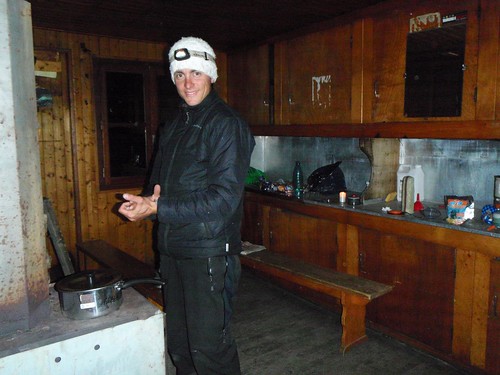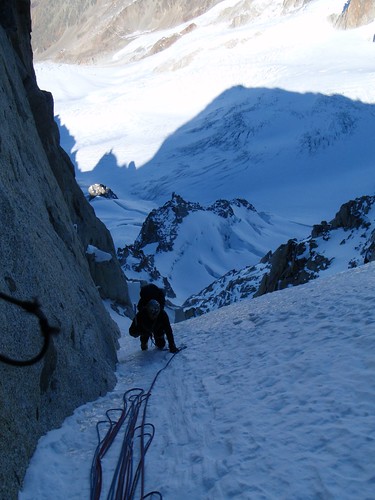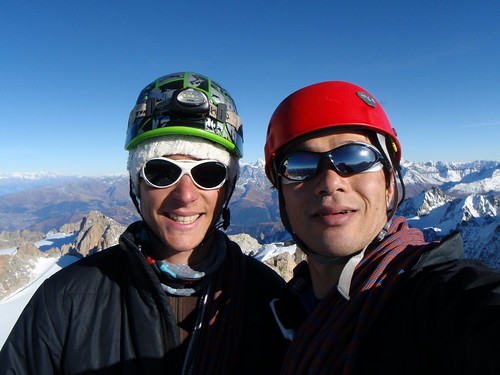Go down, very fast, up, up, to alpine glory
Viewing south from Aiguille du Chardonnet, French Alps.
The closest peak to the left if Aiguille d'Argentière. The pointy peak in the centre is Mont Dolent and the highest to its right is Aiguille de Triolet. The immediate glacier below is Glacier du Chardonnet and that behind the prominent ridge and in front of Aig. Triolet is Glacier d'Argentière.
Summitting — it is one of the primary goals in mountaineering.
Thibault asked me again “What would you like to do?”
The crux pitches, steep ice wall (WI 4, or Scottish V), are just above us and look doable. After all, alpine climbing is all about inventively managing with the minimum gear (said Andy Kirkpatrick). One less axe is one less weight, isn't it? Not all bad. I replied,
“I am happy to carry on, but I have got only one axe, so I can't lead. If you are happy to lead, then let's carry on.”
,
to which Thibault agreed.
So he set off. He seemed to place more screws than the previous pitch. Because it is harder? Maybe. But I guess my fall affected his performance too. He complained lack of screws, but eventually reached the belay (What we didn't realise at that time was, I had apparently lost 2 ice-screws, too, in my big fall. Both those ice screws and my ice axe were held/clipped by krabs, but they were somehow undone in the shock of the fall, apparently.)
Then, my turn to climb comes, with one axe. It turned out it was actually all right, as I gauged it would for me. I did grab screws, when I met them, to save my strength. But I didn't fall and I didn't think at any moment I might fall. I climbed in confidence. The thing is that means technically I could lead the pitch with one axe, as a leader doesn't need or use 2 axes in placing runners. While I climb Scottish V with one axe in confidence, how could I fall on Scottish III with double axes?! I asked myself again in anger.
Thibault let me use one of his axes in the next pitch, the second half of the crux ice pitches, so I lead it. With 2 less screws, I eventually used all the screws, and 10 metres above the last screw at the full-stretch of the 60-metre rope, I was relieved to find a crack to accept the satisfyingly good gear to belay, which I deseparately needed to belay Thibault, who would second with only one axe. Thibault flew up without a trouble, retrieved his other axe from me, and lead the next and last pitch.
From here the route continues diagonally to the left to the summit. But it is also possible to escape to the descent route by traversing right. Or, it is possible to climb on to the right to join the standard route.
We were running late. To continue the route as we were is, though supposedly a lot easier than up to here, not an option. The standard route (PD) would be faster, but we still have a fair bit of way to climb to summit — we can surely summit in daylight, but will be unlikely to return to the hut before the sunset if we do.
Well, we have climbed till this far, and the weather is stable — why not? So we took that (PD) option, moving together.
And after more alpine actions, all at last, we summitted! It is beautiful. And tremendously satisfying. My first alpine peak since my move. There is absolutely no one in our sight. Fantastic.
At the summit of Aiguille du Chardonnet (3824m).
Thibault (Left) and Masa. We climbed Goulotte Charlet-Bettembourg (D+/TD-) till the end of the hard section, then moved off to the standard route to the right to save time for summiting. It took 10 hours for us to reach here, after setting off the hut at 4am. We are still equipped with head-torches at 2pm here…
Descent was … scary, or I was scared. After the fall, I did lose my confidence, and that slowed me down considerably, even though I doubt if it made me/us any safer. But I know and Thibault knows I can't rush, so we proceed patiently. After a long walk and scramble down, as well as 4 abseils (with a bit of stuck rope at one stage) in the middle, we managed to descend down the steepest part of the glacier just before the last light faded away. Another 2 hours descent across the heavily crevassed glacier in dark was not a fun. When we at last arrived back at the hut at 7pm, I was shattered, also being well aware of a pain in my bruises. What a day.
Glacier du Tour and Massif des Aiguille Rouges in the morning.
Shot from Refuge Albert Première at 8am. It was 15 hours activity with 1100metres ascent at altitude the previous day, my bruises hurt, and the condition of the route we had eyed up for on this day appeared to be bad, therefore all in all we decided to just descend back to the valley on this day.
3 December 2011, by Masa Sakano
Note: All the photos are taken by Masa, unless otherwise stated (as copyright). Click each photo (which are linked to Flickr pages) and see the detail. Some of the original photos are found also in Bowline CC Photo Pool in Flickr.
If your browser does not show some of the photos in this page, please try to click here first and then come back to this page and reload this page again.








